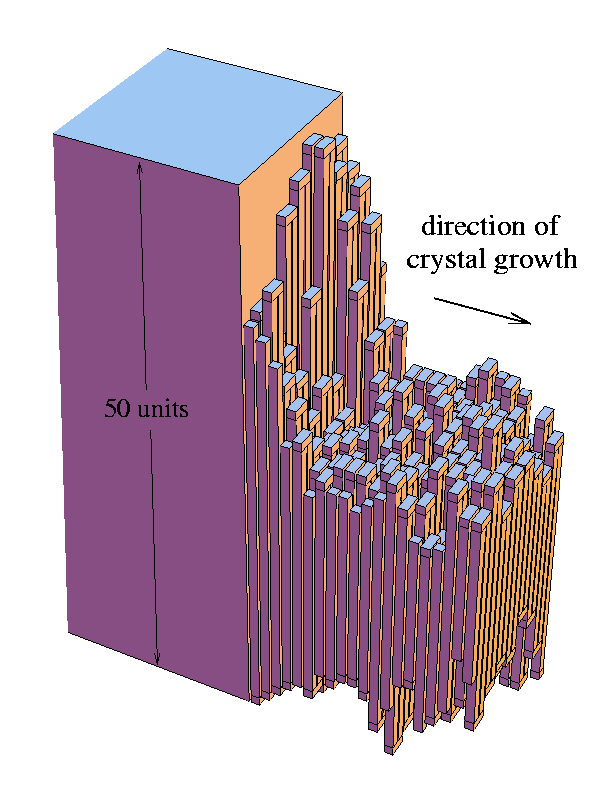|
Research
|
Polymer Crystallization
Simple polymers typically form thin lamellar crystals, where the polymer chains are oriented approximately perpendicular to the plane of the lamella, folding back upon themselves at each surface. However, this morphology is not the most stable---the polymer crystal would have a lower energy if the polymers were completely extended with no folds. Therefore, the morphology must be a result of the dynamics of crystal growth. The two dominant theories (surface nucleation and Sadler-Gilmer) that attempt to explain this behaviour, particularly the dependence of the thickness and the growth rates of the crystal on temperature, make a number of assumptions about the microscopic mechanisms of crystallization. It was the aim of my post-doctoral research with Daan Frenkel to use computer simulation and modelling to test some of these assumptions. However,
our simulations revealed a mechanism of thickness selection that differed
from both the existing theories. We found that at a particular temperature
there is only one dynamically-stable thickness at which crystals can grow with constant
thickness. Thicker (thinner) crystals thin (thicken) as they grow until
this critical thickness is reached. This mechanism is illustrated by the
adjacent cut through a polymer crystal that was grown in our simulations.
The crystal thins to the stable thickness within 5-10 layers and then continues
to grow at that thickness. One way to provide experimental support for
this mechanism would be to examine the profile of the steps on the surface
of a polymer crystal that result from changes in temperature during growth.
However,
our simulations revealed a mechanism of thickness selection that differed
from both the existing theories. We found that at a particular temperature
there is only one dynamically-stable thickness at which crystals can grow with constant
thickness. Thicker (thinner) crystals thin (thicken) as they grow until
this critical thickness is reached. This mechanism is illustrated by the
adjacent cut through a polymer crystal that was grown in our simulations.
The crystal thins to the stable thickness within 5-10 layers and then continues
to grow at that thickness. One way to provide experimental support for
this mechanism would be to examine the profile of the steps on the surface
of a polymer crystal that result from changes in temperature during growth.
Associated Publications
- J.P.K. Doye, Polymer 41, 8857-8867 (2000)
Computer simulations of the mechanism of thickness selection in polymer crystals - J.P.K. Doye and D. Frenkel, Polymer 41, 1519-1528 (2000)
The effect of temperature jumps during polymer crystallization - J.P.K. Doye and D. Frenkel, J. Chem. Phys. 110, 7073-7086 (1999)
The mechanism of thickness selection in the Sadler-Gilmer model of polymer crystallization - J.P.K. Doye and D. Frenkel, J. Chem. Phys. 110, 2692-2702 (1999)
Kinetic Monte Carlo simulations of the growth of polymer crystals - J.P.K. Doye and D. Frenkel, J. Chem. Phys. 109, 10033-10041 (1998)
Crystallization of a polymer on a surface - J.P.K. Doye and D. Frenkel, Phys. Rev. Lett. 81, 2160-2163 (1998)
Mechanism of thickness determination in polymer crystals
Home Publications Research Links Cambridge Cluster Database